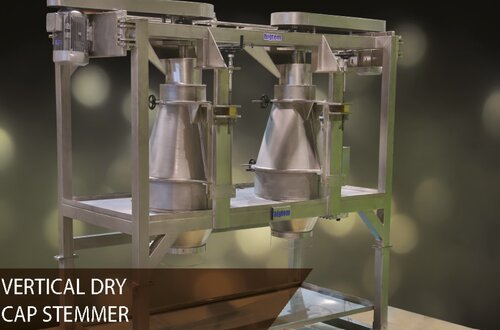Raisin Processing Line
For a long time, the raisin processing line has been a major source of the difficulty. This fruit's drying and pretreatment activities have been thoroughly researched. However, to produce high-quality raisins and gain customer acceptability, quality qualities must be given special consideration.
Grape quality parameters such as colour, texture, vitamins, phytochemicals, fragrance profile, and microbiological stability are critical since they might change during the dehydration process, influencing quality perception and customer choice. Raisin is typically created by sun drying a variety of grape varieties. They have a wrinkled appearance and are petite and delicately tasting.
The method for manufacturing raisins has been known since antiquity, and proof of their creation has been discovered in ancient Egyptian literature. The majority of raisins are tiny, wrinkled, and black. They have a flavour that is comparable to that of the grapes from which they are formed, but the drying process concentrates the quantity of sugar in them, making them sweeter. Because of their low moisture and pH, they are a naturally stable food that resists deterioration.
Natural and artificial drying processes are used in the raisin processing line. Sun-dried and dried-on-vine are two natural processes, whereas hot air dryers are artificial ones. Because of the price, natural approaches are frequently selected. The moisture content of raisins is decreased from around 75% to under 15% after drying, providing approximately 1 kilogram of raisins from 4 kg of grapes. The ultimate grape colour shift to brown or dark brown is dependent on the grape cultivar and drying method, and the drying process has a significant impact on sensory quality.
Although pre-treating the grapes with NaOH and obtaining raisins with microwaves both result in a loss of ascorbic acid and minerals, they do so at the expense of an increase in total phenol content. Microwave treatment boosts antioxidant activity, but NaOH pre-treatment decreases it. Microwaves may be recommended as a method of getting raisins based on these findings. Only use a NaOH pre-treatment if it's required to speed up the procedure. Blanching and other gentle heating treatments have no effect on the bioactive chemicals in grapes or the antioxidant potential of the fruit.
Raw material for Raisin Processing Line
Raisins are mostly made from grapes as a basic material. Over 4 lb of fresh grapes is needed to create 1 lb of raisins. To yield high-quality raisins, these grapes must possess particular characteristics. They must, for example, ripen quickly and dry easily.
They must also have a soft texture, avoid sticking together when kept, be seedless, and have a pleasant flavour. Thompson Seedless, Black Corinth, Fiesta, Muscats, and Sultans are the most significant grapes for the raisin processing line.
The Thompson seedless grape is a white, thin-skinned fruit that produces the greatest raisins currently available. It has oblong and elongated tiny berries. Thompson grapes are great for raisin production since they mature early in the season and do not adhere to one other during shipment. The Thompson Seedless type of raisin grape is by far the most popular. Over half of the world's raisins are processed using them in the raisin processing line. The Thompson seedless grape is a white, thin-skinned fruit that produces the greatest raisins currently available.
It has oblong and elongated tiny berries. It has a high sugar content and contains no seeds. From the perspective of a raisin processing line. The Black Corinth grape, which originated in Greece, has grown to be an important raisin grape variety. Because they ripen early and dry rapidly, they yield nice raisins and are ideal for raisin processing lines. They're more commonly used for making cookies, speciality bread, and fruitcakes than for eating because of their taste.
Muscat grapes are the next most important component of the raisin processing line. These are huge, tasty grapes with a few seeds within. Before the Thompson, these grapes were the predominant raisin grape and were farmed in Alexandria, Egypt. Muscat grapes are sweet and juicy, with a dull green appearance and a muscat taste. They have somewhat tough skins and produce huge, soft-textured raisins with good flavour.
When they're used to make raisins, they go through a mechanical procedure that eliminates the seeds after the grapes have been dried. These seeds are a major disadvantage of utilizing the muscat, and they also don't travel properly.
Raisins include essential nutrients such as sugars, fruit acids, and mineral salts. Sugars are an excellent source of carbs. Fruit acids that have been demonstrated to stimulate development, such as folic acid and pantothenic acid, are also important components. Raisins include vitamin B6, which is a vital component of the human diet.
Calcium, magnesium, and phosphorus are all important elements found in raisins. In addition, raisins contain trace levels of iron, copper, zinc, and other minerals. Given the makeup of raisins and the fact that they contain no fat, it's no surprise that they're regarded as a healthy snack. By surprise, the Raisin Processing Line was uncovered.
It's possible that our forefathers stumbled across fallen fruit that had dried in the sun and tasted it to discover its sweetness. The Egyptians manufactured raisins as early as 2000 B.C., according to evidence. Raisins have been recorded in ancient manuscripts, implying that they were formerly used for eating, curing ailments, and even paying taxes.
Winemaking has long been the most significant use for grapes, but a tiny portion of these grapes has always been converted into raisins. Grapes were brought to the United States by Spanish missionaries from Mexico in the late 1800s. Many of the California wineries planted by these missionaries are still producing today. These are the first vineyards.
Methods in Raisin processing line
The natural, dehydration, continuous tray, and dried-on-the-vine procedures are the four basic processes used in the raisin processing line. The natural technique, which will be discussed in depth, is the most popular of them. Harvesting, processing, and packing are the three essential phases in the natural raisin processing line. While a tiny percentage of raisins is generated by mechanically dehydrating grapes, the vast majority are dried in the sun.
Growing nice grapes in the vineyards is the initial stage in the raisin processing line's production of good raisins. Grape cultivation, which takes place all year, includes pruning, watering, fertilizer, and insect control. In these vineyards, the majority of the work is still done by hand. Pruning is the process of removing portions of the vine to manage its growth pattern. This provides the advantages of ensuring consistent grape quality across the vineyard, as well as making other agricultural activities easier and lowering expenses.
The grapes are picked beginning in late August and continuing through September. Field workers handpick grape bunches and deposit them on paper trays spread out on the ground between the vine rows. Depending on the weather, the grapes are left to dry on the trays for two to four weeks. The moisture content of the grape drops from 75% to under 15% during this period and the colour of the fruit changes to a brownish purple.
The paper trays are folded up around the raisins to make a bundle when the fruit has dried. Before being delivered by truck to a raisin processing plant, the rolls are collected and kept in boxes or bins.
When the raisin processing line receives the rolls of fruit, they are emptied onto wire screens and shaken to remove dirt and other debris. They are also examined to verify that they fulfil the requirements set forth earlier. The US Department of Agriculture inspects dried raisins in the United States to guarantee that all state and federal food rules are followed. The cargo is evaluated based on factors such as moisture content, colour, and flavour.
The raisins are classified as either standard or poor depending on their quality. Only standard-graded raisins can be utilized right away. The raisin processing line receives the dried grapes from the storage bins. They are mechanically changed after being dumped onto a conveyor belt. The raisins are first passed through a fine mesh screen while air is blasted on them to remove any remaining sand or dirt. Immature fruit is removed using suction equipment. The raisins are then separated from the bunch stem by shaking.
Each raisin's cap stems are removed by passing it through two revolving conical surfaces. If the raisins have seeds, they are manually removed. After all of these processing procedures are done, the raisins are sorted by size using a succession of mesh filters.
Our Principal
Kiron Food Processing Technologies, in association with Bigtem, provides a full solution for your raisin processing line requirements. Bigtem is a world leader in this industry, producing processing lines for more than half of the raisins produced worldwide. With the manufacturing lines it has created in the last ten years, Bigtem has given traditional processing methods a whole new viewpoint.
Bigtem's raisin processing lines combine the greatest levels of sanitation with the lowest operational and capital expenses. Our simple-to-use, low-maintenance lines provide shredding, rewashing, and packing services to countries such as Germany, the Netherlands, England, and Canada, where grapes are not grown but merely consumed.








